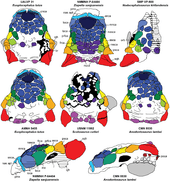Nodocephalosaurus
| Nodocephalosaurus Temporal range: Late Cretaceous, Campanian | |
|---|---|
| Scientific classification | |
| Kingdom: | Animalia |
| Phylum: | Chordata |
| Class: | Reptilia |
| Clade: | Dinosauria |
| Order: | †Ornithischia |
| Family: | †Ankylosauridae |
| Subfamily: | †Ankylosaurinae |
| Genus: | †Nodocephalosaurus Sullivan, 1999 |
| Species: | †N. kirtlandensis |
| Binomial name | |
| Nodocephalosaurus kirtlandensis Sullivan, 1999 | |
Nodocephalosaurus is a genus of herbivorous ankylosaurine ankylosaurid dinosaur from Upper Cretaceous (late Campanian stage) deposits of San Juan Basin, New Mexico. The holotype was recovered from the Late Campanian De-na-zin Member of the Kirtland Formation and consists of an incomplete skull. Nodocephalosaurus (Greek nodus = knob, kephale = head and sauros = lizard) is a monotypic genus, including only the type species, Nodocephalosaurus kirtlandensis. Dinosaurs like Nodocephalosaurus resembled Asian forms, and may be evidence for Asian dinosaurs migrating to North America in the Late Cretaceous.[1]
Description and classification

The pattern of cranial ornamentation present in this ankylosaurid "is distinguished by semi-inflated to bulbous, polygonal, cranial osteoderms that are bilaterally and symmetrically arranged on the frontonasal region of the skull",[2] and includes deltoid quadratojugal flanges and pyramid-shaped squamosal bosses.
The type description noted the taxon's similarity to the Monogolian ankylosaurids Saichania chulsanensis and Tarchia gigantea, and suggested that these three taxa form a clade within the subfamily Ankylosaurinae. However, Vickaryous and others consider this assignment provisional and list the genus as Ankylosaurinae incertae sedis.[3]
There is also evidence of a paranasal sinus cavity in the maxilla. Sullivan also noted that material previously collected from the Kirtland Formation and assigned to the taxa Euoplocephalus or Panoplosaurus might actually represent additional remains of Nodocephalosaurus.[2]
See also
Footnotes
References
- Lehman, T. M., 2001, Late Cretaceous dinosaur provinciality: In: Mesozoic Vertebrate Life, edited by Tanke, D. H., and Carpenter, K., Indiana University Press, pp. 310–328.
- Sullivan, R. 1999. Nodocephalosaurus kirtlandensis, gen et sp nov., a new ankylosaurid dinosaur (Ornithischia; Ankylosauria) from the Upper Cretaceous Kirtland Formation (Upper Campanian), San Juan Basin, New Mexico. Journal of Vertebrate Paleontology 19(1):126-139.
- Vickaryous, Maryanska, and Weishampel 2004. Chapter Seventeen: Ankylosauria. in The Dinosauria (2nd edition), Weishampel, D. B., Dodson, P., and Osmólska, H., editors. University of California Press.